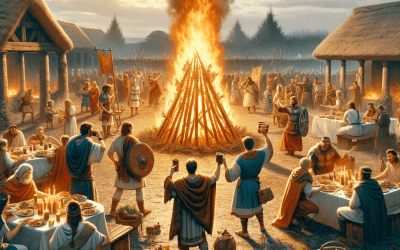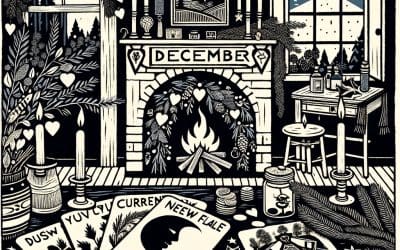LEARN | PAGAN HOLIDAYS | YULE
EVERYTHING YOU NEED TO KNOW ABOUT YULE
Updated: December 17, 2023
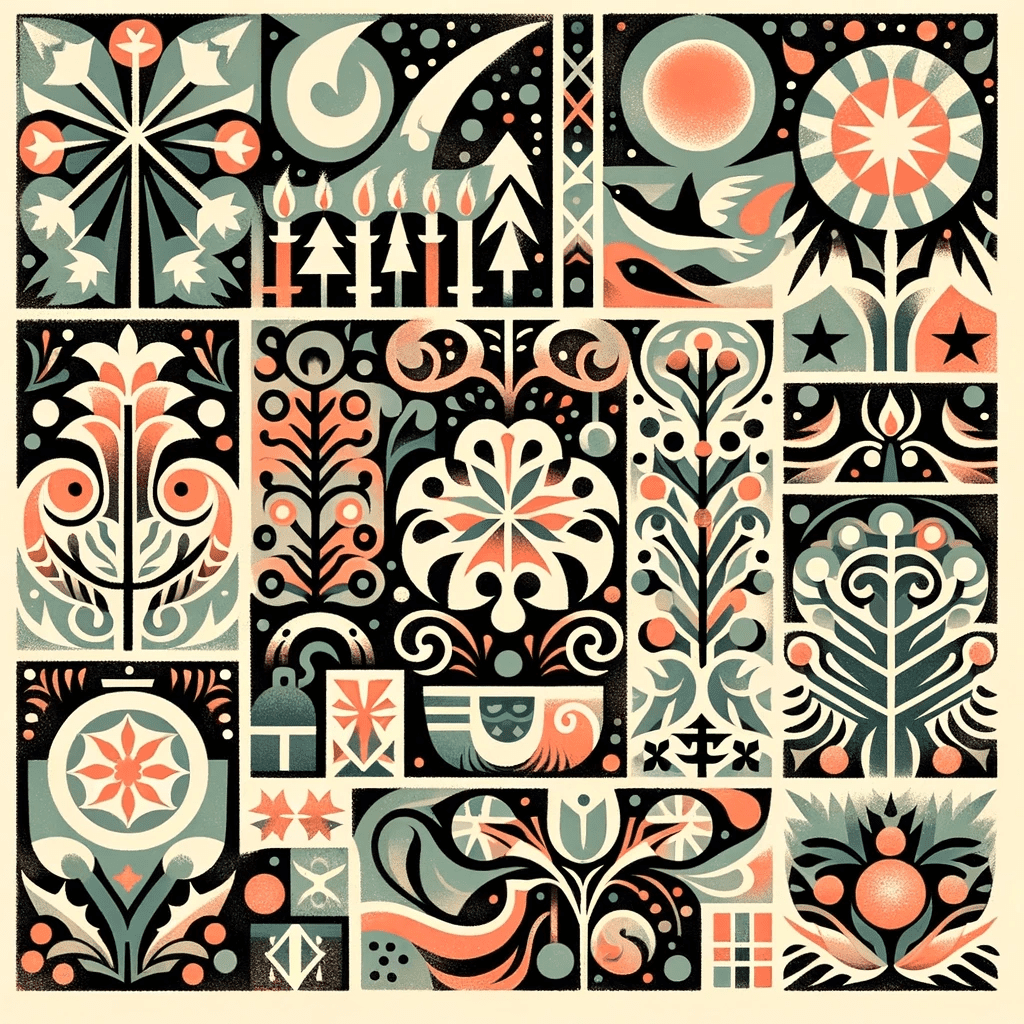
YULE OVERVIEW
Falling within winter’s grasp, Yule is a celebration marking the Winter Solstice, characterized by rich traditions, symbolism, and the embrace of nature’s slumber. Known also as Midwinter, this ancient festival lights up the darkest days, kindling hope for brighter times.
When is Yule?
In 2023, Yule is on December 21st. For many modern Pagans and Wiccans, Yule is one of the eight Sabbats and is celebrated at the time of the Winter Solstice, which is around December 21st or 22nd in the Northern Hemisphere. This is the time of year when the night is longest and the day is shortest, marking the point where the days start to grow longer again as the sun seems to be reborn.
How Many Days is Yule Celebrated?
In the ancient tapestry of pagan traditions, Yule wasn’t just a pop-up event; it was more like a festival marathon. Think of it as the original extended holiday season, where ancient folks knew how to party with purpose and a touch of the mystical.
Norse and Germanic Cultures: A 12-Day Winter Saga
In the lands of the Norse and Germanic tribes, Yule was the winter celebration equivalent of a Netflix binge-watch session, but way cooler and with actual gods. Lasting for 12 days, this Yule-tide was the real deal. Starting at the Winter Solstice and rolling into early January, it was a time of feasting (imagine the kind of dinner parties where no one wants to leave), hearty toasting (to health, to gods, to that neighbor who finally returned your ox), and rituals that were less about formality and more about celebrating the sun’s comeback tour.
Anglo-Saxon Celebration: When “Geol” Ruled the Days
Over in Anglo-Saxon England, they had their own version of this extended holiday. Known as “Geol” (which sounds less like a holiday and more like something you’d say when you stub your toe, but let’s roll with it), this was their take on Yule. Historical whispers hint at a festival stretching over several days, in sync with the Norse’s love for 12-day revelries. This wasn’t just a festive fling; it was a full-blown seasonal romance with winter.
The reason behind these extended celebrations? It’s simple: the agricultural calendar. When you’re living off the land, the Winter Solstice isn’t just a cool celestial event; it’s your cue to take a break. Fields are sleeping under frost, the harvest is in, and it’s time to party down, pagan-style.
What is the Origin of Yule?
Yule, also known as Yuletide, originates from ancient Germanic and Nordic cultures, where it was known as Jól in Old Norse and Geōl in Old English. The term “Yule” is still used in Scandinavian languages to refer to Christmas. The event was absorbed into Christian traditions as Christmas but has been revived by many modern Pagans and Wiccans.
The Colors, Crystals, Scents, Herbs, Plants, Flowers, and Symbols of Yule
As we welcome the winter solstice, Yule invites us into a world shimmering with icy hues, rich scents, and symbols that echo the quiet power of the season. This time of year is about celebrating the return of light, embracing the stillness of winter, and honoring the cycles of nature. Let’s unwrap the wintery charm of Yule and see how you can infuse your celebrations with its mystical essence.
Colors
- White: Symbolizing snow and purity, it reflects the blank slate of the winter landscape.
- Red & Green: Classic Yule fashion, like your favorite ugly sweater but less itchy. Red for energy and green for renewal – think of them as your spiritual espresso shot.
- Blue: Echoes the crisp winter sky, reflecting serenity and introspection.
- Gold and Silver: Shiny and bright, these colors are like the disco balls of Yule, bringing in the bling and celebrating the return of the sun.
Crystals
- Snow Quartz: Resonates with the purity and quiet of a snowy landscape.
- Garnet: Symbolizes the inner fire, keeping the spirit warm in cold times.
- Bloodstone: Reminds us of the resilience and renewal of life.
- Clear Quartz: Amplifies energy and thought, mirroring the clarity of winter air.
- Ruby: Because who doesn’t want a bit of sparkle during the darkest days? It’s like carrying a piece of holiday cheer in your pocket.
Scents
- Pine: Brings the crisp, clean scent of evergreen forests into your space. That ‘walking in a winter wonderland’ vibe indoors, minus the frostbite.
- Peppermint: Invigorates and refreshes, like a brisk winter breeze.
- Myrrh: A deep, warm aroma that encourages reflection and spiritual connection.
- Cedar: Grounding and comforting, like a cozy cabin sheltered in a winter forest.
- Cinnamon and Clove: The olfactory equivalent of a warm hug from your favorite aunt who always slips you an extra cookie.
Symbols
- Yule Log: It’s like the holiday version of a campfire, bringing light, warmth, and maybe a marshmallow or two to the longest night of the year.
- Evergreen Wreath: Represents eternal life and the enduring spirit.
- Snowflakes: Each one unique, symbolizing the beauty of individuality and change.
- Candles: Their light is a tribute to the sun’s return after the longest night.
- Wheel of the Year: A reminder that everything keeps rolling, even when you’re up to your ears in wrapping paper and holiday to-do lists.
Herbs, Plants, and Flowers
- Holly: Symbolizes protection and the enduring life force. Plus, they’re a great reminder to keep things lively (and a bit prickly) during family gatherings.
- Mistletoe: The ultimate excuse for some Yule smooches. Represents peace, love, and the continuation of life. Just hang it up and let the magic happen, no swiping required.
- Ivy: A sign of resilience and clinging to life and light in the darkest times.
- Poinsettia: The bright red color of the Poinsettia’s bracts (often mistaken for its flowers) is reminiscent of the sun, a key symbol of the Winter Solstice.
What is the Symbolism of Yule?
Yule symbolizes rebirth and renewal, mirroring nature’s cyclical patterns. It marks the Winter Solstice, the shortest day of the year, heralding the return of longer, brighter days. The Yule log, holly, mistletoe, and evergreen wreaths are enduring symbols of this celebration, representing life’s resilience amidst winter’s harsh reign.
Pagan Beliefs About Yule
As the chill of winter embraces the Northern Hemisphere, different Pagan traditions gather to celebrate Yule, marking the return of the sun and the promise of brighter days. Each tradition brings its unique rituals and symbolism to this ancient festival.
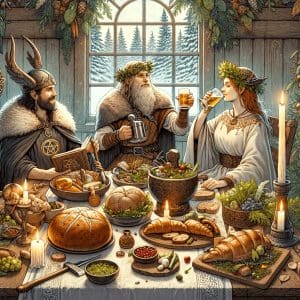
Wicca
For Wiccans, Yule is a celebration of the sun god’s rebirth. Rituals often involve candle lighting and altar decorations with evergreens and sun symbols, reflecting on the past and future.
Norse Paganism/Heathenry
Norse Pagans observe Yule with feasts and toasts to Odin. The Yule log’s lighting is central, accompanied by traditions like the Wild Hunt, symbolizing a mystical, transformative time.
Druidry
Druids celebrate the Winter Solstice as a time of balance between light and dark. Dawn ceremonies, storytelling, and music are common, focusing on the sun’s rebirth at sacred sites like Stonehenge.
Each of these traditions honors Yule as a time of darkness turning into light, embodying themes of renewal and hope.
Yule Traditions and Customs
The Yule Log
The burning of the Yule log is a tradition stemming from the ancient Celts, believed to bring good luck and protect the home.
The Evergreen Wreath
Evergreen wreaths, symbolizing eternal life, are commonly crafted and displayed to honor nature’s unyielding spirit.
Wassailing
Wassailing, an Old English custom of toasting to good health, is another lively tradition often involving song, dance, and a shared beverage, typically a warmed cider.
Yule Lore
The Yule Lads
From Icelandic folklore, meet the Yule Lads, a merry yet mischievous band of thirteen trolls who, starting 13 days before Yule, visit children across the country each night. Each Lad has peculiar habits, ranging from slamming doors to licking spoons!
Mōdraniht
This Old English tradition, known as “Mother’s Night,” is believed to have been a significant part of Yule celebrations in pre-Christian Britain. Mōdraniht, celebrated on what we now call Christmas Eve, was a time to honor the female ancestral spirits and goddesses.
Odin’s Great Yule Hunt
In some traditions, Odin, the Allfather in Norse mythology, is believed to lead a great hunt during the Yule season, riding his eight-legged steed Sleipnir across the night sky. This Great Yule Hunt was both awe-inspiring and a little frightening, serving as a reminder of the wildness of nature even in the season of slumber.
Yule Deities
Odin
In Norse mythology, Odin, the Allfather, is celebrated during Yule, a god of wisdom, magic, and war.
The Green Man
Also known as the Oak King in Celtic folklore, the Green Man, a symbol of rebirth and growth, is venerated during Yule.
Frigga
In Norse beliefs, Frigga, Odin’s wife, goddess of hearth and home, is often honored during Yule for her associations with familial and domestic warmth.
Traditional Yule Foods
Yule customs are replete with delicious, hearty foods. Traditional fare includes Yule ham, gingerbread, mulled wine, roast goose, and spiced cakes and biscuits. Let’s dive into the heartwarming and stomach-filling aspect of the celebration: the food. From hearty roasts that echo our ancestral past to spiced drinks that warm the soul, each dish in the Yule feast is a fusion of tradition, nature’s bounty, and a dash of culinary magic. Join us on a flavorful journey through the traditional foods of Yule, where history, culture meet on a plate.
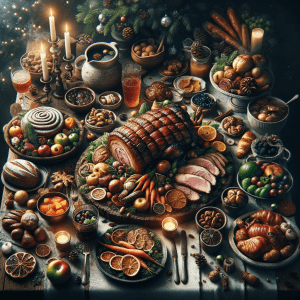
Meat, Gloriously Roasted
We’re talking pork or beef – taking center stage at your Yule feast. It’s like a culinary high-five to ancient feasts, where meat was the MVP.
Root Veggies: The Underground Heroes:
Digging into the earth, we uncover root veggies like carrots and potatoes. They’re like the unsung heroes of the winter table, humble yet indispensable, representing the Earth’s resilience and our ability to find joy in simplicity.
Nuts and Berries: Nature’s Snack Pack
Break out the nuts and berries, folks. They’re nature saying, “Here, have a snack for your survival.” Hazelnuts, walnuts, the occasional berry.
Mulled Wine or Cider: The Adult Warm Hug
Spiced, warm, and slightly intoxicating, mulled wine (or cider for the sober squad) is like a magic potion against the cold. It’s a reminder of the sun’s warmth, now a distant memory, and a promise of its return.
Yule Log Cake: Edible Artistry
Who doesn’t want a cake that looks like a tree stump? The Yule Log Cake is the runway model of the dessert world. It symbolizes the Yule log’s enduring warmth and a delicious excuse to eat more chocolate.
Fruits and Preserves: Sweet Echoes of Summer
Winter fruits and jams are like edible postcards from summer, reminding us of the sun-kissed days. They’re little bursts of joy amidst the cold, symbolizing nature’s enduring generosity.
Dark Leafy Greens: The Stalwarts of Winter
These greens are the quiet warriors of the winter garden. They don’t just add color to our plates; they’re a testament to endurance, teaching us that there’s life and strength, even in the bleakest times.
Yule Log Cake: Edible Artistry
Who doesn’t want a cake that looks like a tree stump? The Yule Log Cake is the runway model of the dessert world. It symbolizes the Yule log’s enduring warmth and a delicious excuse to eat more chocolate.
Fruits and Preserves: Sweet Echoes of Summer
Winter fruits and jams are like edible postcards from summer, reminding us of the sun-kissed days. They’re little bursts of joy amidst the cold, symbolizing nature’s enduring generosity.
Breads & Pastries: Carbs Are Life
Baking bread and pastries for Yule is like wrapping yourself in a warm blanket. Whether shaped into symbolic forms or just a delicious blob, they represent comfort, community, and the joy of sharing.
Gingerbread: Spicy & Structurally Sound
Gingerbread is Yule’s multitasker – a cookie, a decoration, a craft project. If you’re feeling ambitious, build a house. If not, a gingerbread man still counts.
Fish or Seafood: Ode to the Sea’s Bounty
For those near the coast, seafood is a Yule staple, offering a different kind of feast. It’s a salute to the ocean’s gifts, a reminder of the world’s natural diversity and abundance.
Is Yule Still Celebrated Today?
Yes, Yule is still celebrated today, particularly among those who identify as Pagans, Wiccans, or simply nature-lovers seeking to honor the season’s cycle. Many traditions have been incorporated into mainstream holiday celebrations as well, making Yule’s spirit more widespread than one might initially realize.
The Significance of Yule
Yule embodies a powerful duality: embracing the beauty of darkness while celebrating the promise of light’s return. It’s a time of gratitude for what we have, the hope for what’s to come, and the beauty of life’s enduring cycle.
10 Easy Ways to Celebrate Yule
Light a Yule Log
This can be an actual log, or a simple candle to symbolize the return of light.
Craft an Evergreen Wreath
Celebrate the resilience of nature by creating and displaying an evergreen wreath.
Enjoy Yule Foods
Cook traditional Yule foods to share with family and friends.
Hold a Solstice Vigil
Spend the longest night in quiet reflection, welcoming the return of the sun at dawn.
Make a Yule Altar
This can be decorated with symbols of the season like holly, mistletoe, and images of the sun.
Donate to a Good Cause
As a season of giving, consider supporting a charity or those less fortunate.
Nature Walk
Embrace the beauty of winter with a brisk walk in nature.
Wassail
Hold a small gathering with loved ones, toasting to health and happiness.
Sunrise Yoga
Welcome the returning sun with some gentle, warming yoga.
Share Stories
Share tales of Yule lore, fostering a sense of wonder and connection with ancient traditions.

